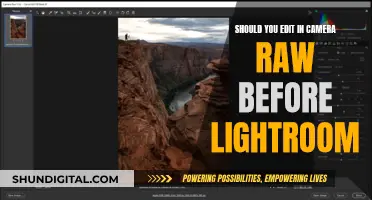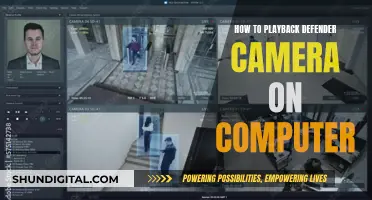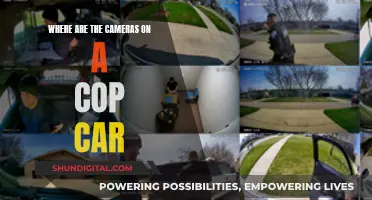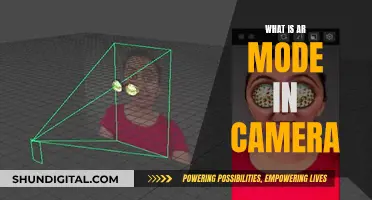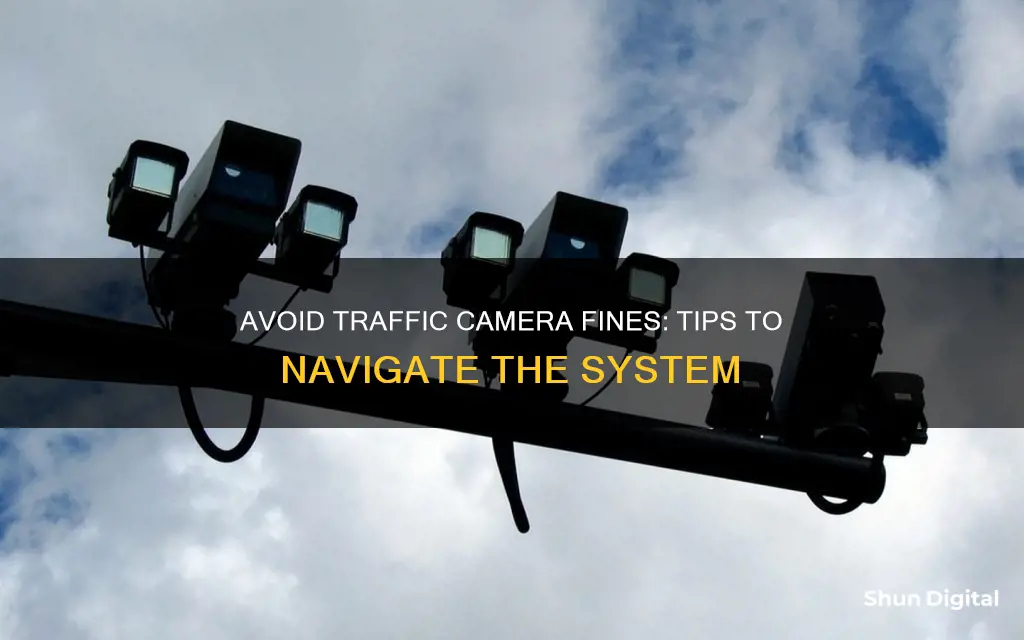
Traffic camera fines are issued when a camera detects a vehicle that does not follow specific road rules, laws, or regulations. These include speeding, running a red light, or driving in a bus lane. The registered operator or owner of the vehicle is usually held responsible for the fine. However, there are instances where the operator can demonstrate that they were not driving at the time of the offence, such as when the vehicle or number plates were stolen. In some places like Texas, there is a ban on the use of red-light cameras for issuing fines, and fines are not counted against the driver's record or increase insurance costs. Each state or territory has its own online portal for checking, paying, or appealing traffic camera fines.
| Characteristics | Values |
|---|---|
| Time to receive fine | The average time to receive a speed camera fine is about two weeks in most states, but it can take up to 28 days in NSW and as little as four days in Tasmania. |
| Payment methods | Online, BPAY, Australia Post, transport and motoring service centre, or by post. |
| Payment deadline | 28 days from the issue date shown on the fine/infringement. |
| Payment plan | Available for fines of $200 or more. |
| Nominate another driver | Possible if someone else was driving, the vehicle or number plates had been stolen, or the vehicle had been sold. |
| Dispute fine | Possible if you have evidence or information to support your claim. |
| Court hearing | Possible if you disagree with the outcome of your dispute. |
| Request photo | Possible to request a photo of the offence, which can be viewed online or requested in writing from Fines Victoria. |
What You'll Learn
- Payment methods vary by state/territory and include online, in-person, and by mail
- You can request a copy of the photo used as evidence
- If you cannot afford to pay, you can ask to pay in instalments
- If you were not the driver, you can nominate another driver
- If you don't pay, there may be consequences such as blocked vehicle registration

Payment methods vary by state/territory and include online, in-person, and by mail
Payment methods for traffic camera fines vary by state/territory. In Queensland, Australia, you can pay your fine online, in person, or by mail. If your fine has a payment reference number, you can pay the full amount or the first instalment (for fines of $200 or more) online. You can also pay by logging into your account and selecting an infringement to pay if you have lost your infringement notice or did not receive it. Additionally, you can set up a payment plan online for fines of $200 or more.
For handwritten fines, you must wait until the details have been recorded on the system, which can take up to 21 days. After this, you can pay online, even if you have lost the fine. However, if it takes longer than 21 days to be recorded, you may need to pay in person or by post. Handwritten fines cannot be paid at Australia Post and must be paid at a transport and motoring service centre or by sending a cheque or money order by mail.
In Victoria, Australia, you can view the photo of your offence online by logging in and entering an obligation or infringement number, along with some personal or vehicle registration details. If you cannot afford to pay the fine in full, you can request to pay in instalments or ask for more time to pay.
In Texas, USA, traffic camera tickets are a civil violation and do not count against your driving record or increase insurance costs. While most cities have stopped using red-light cameras due to a statewide ban, there are still some instances where drivers may receive a ticket. Whether or not you choose to pay these fines depends on your personal approach to risk and your confidence in contesting them legally.
In Iowa, USA, traffic camera citations are civil code infractions and will not affect your DOT record or driver's license. However, if you do not pay the fine in a timely manner, the city can place a civil lien against your license plates, impacting your vehicle registration.
Focusing Your LG K20 V Camera: Tips and Tricks
You may want to see also

You can request a copy of the photo used as evidence
If you have received a traffic fine, you can request to view the photo used as evidence against you. This is useful if you have deleted or lost your fine and need to see the details of your offence.
To view the photo of your offence, log into the government website responsible for issuing fines. You will need to enter an obligation or infringement number for one of your fines, along with some other personal details, such as your driver's licence or vehicle registration details. Once you have logged in, you will see a list of your fines. Click 'Photo' next to the relevant fine to view or download the photo. If there is no 'Photo' link, this means there is no photo available on the website. If the offence occurred more than six months ago, you can contact the relevant authority and ask if an image of the offence is available.
In Queensland, for example, you can log into your account to check if your fine has been recorded on the system and pay online, even if you have lost the original fine. You can also request a copy of your fine online if you have deleted or lost it.
Bing Camera Battery: What Powers These Devices?
You may want to see also

If you cannot afford to pay, you can ask to pay in instalments
If you are unable to pay your traffic camera fine in full, you can request to pay in instalments. This option is available for those who meet certain criteria and are unable to pay their fine in one lump sum.
To set up a payment plan, you will need to make a first payment within 28 days of the issue date of the fine. This first payment must be at least $60. After this, you can pay your fine in monthly or fortnightly payments. You can also choose to have your payments automatically deducted from your Centrelink payment.
If you have a payment reference number, you can pay the first instalment online, by BPAY, or at Australia Post. If your fine does not have a payment reference number, you can pay the first instalment online by choosing the fine under 'Current Infringements' and selecting the 'Set up payment plan' option. You can also pay your first instalment at any transport and motoring service centre or by sending a cheque or money order by post.
Once you've set up your payment plan, you will be informed when your voluntary instalment plan payments are due. If you have signed up for e-reminders, you will receive an email reminder five days before payment is due.
Enterprise Car Cameras: Privacy or Security?
You may want to see also

If you were not the driver, you can nominate another driver
You should nominate the driver as quickly as possible. In New South Wales, you must lodge the nomination within 21 days of the issue of the penalty notice, in accordance with Section 186 of the Road Transport Act 2013. In Queensland, you have 28 days from the issue date shown on the fine to transfer the fine. If you do not nominate within this time, the offence and demerit points will be attributed to you as the registered vehicle owner.
If your nomination is successful, the fine will be reissued to the nominated driver. You should not pay the fine, even if the other driver is a family member. Wait for the fine to be reissued to the nominated driver before making a payment.
It is important to note that making a false nomination is a serious offence. If you provide false or misleading information, you may receive additional fines and restrictions on your driver's license.
Adjusting Computer Cameras: A Step-by-Step Guide
You may want to see also

If you don't pay, there may be consequences such as blocked vehicle registration
If you receive a traffic camera fine, it's important to take action and not ignore it. While it may be tempting to disregard the fine, doing so can lead to several consequences that will only make the situation more difficult and costly for you in the long run.
One possible consequence of not paying a traffic camera fine is the blocking of your vehicle registration. This means that you won't be able to renew your vehicle's registration until the fine is paid in full. This can cause significant inconvenience, especially if your vehicle is your primary means of transportation. In some cases, you may even be prevented from registering a new vehicle until the matter is resolved.
In addition to blocking vehicle registration, unpaid fines can also result in enforcement action by the relevant authorities. For example, in the state of Ohio, failure to respond to a camera ticket or appear in court can lead to a driver's license suspension. This will further limit your ability to legally operate a vehicle and can have a significant impact on your daily life. The consequences don't stop there; unpaid fines can also result in increased financial costs. The longer you ignore the fine, the higher the penalties and fees will become. Sheriff's officers have the authority to enforce unpaid fines by seizing and selling your property, wheel clamping or selling your vehicle, or removing the number plates. These actions will only add to the cost and inconvenience of dealing with the original fine.
It's also important to note that ignoring a traffic camera fine can negatively impact your driving record. Even though camera tickets typically don't appear on your driving record, failing to address the fine can result in demerit points being allocated to your record. This can lead to increased insurance premiums, as insurance companies view these points as a sign of increased risk. Furthermore, a negative driving record can affect your ability to drive or obtain licenses in the future.
To avoid these consequences, it's crucial to take prompt action when you receive a traffic camera fine. You have several options to deal with the fine, including nominating the responsible driver, requesting a court hearing, or applying for more time to pay or a payment plan. By taking responsibility and addressing the fine, you can avoid the more serious repercussions of ignoring it. Remember, dealing with the fine in a timely manner will help you save money, maintain your driving privileges, and keep your vehicle registration up to date.
Troubleshooting Computer Camera Issues: What You Need to Know
You may want to see also
Frequently asked questions
If you receive a traffic camera fine, you should take action to deal with it. You can nominate the responsible driver, request a court hearing, apply for more time to pay, or apply to pay by instalments. Ignoring the fine may result in further penalties, such as an enforcement warrant from the Magistrate's Court, which can lead to costly consequences.
The process for paying a traffic camera fine varies depending on your location. In Queensland, you can pay online, at Australia Post, or at a transport and motoring service centre. In Victoria, you can pay online, by BPAY, or at a Post Office or Australia Post outlet. In Texas, the law surrounding traffic camera fines is ambiguous, and it is recommended to consult a lawyer for advice.
If you cannot afford to pay the fine in full, you may be able to apply for a payment plan or pay in instalments. In Queensland, you can set up a payment plan online or by contacting the Queensland Revenue Office. In Victoria, you can apply to pay in regular instalments, and your payments can be automatically deducted from your Centrelink payment.


